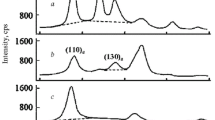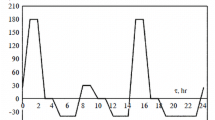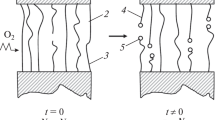The influence of the spinneret draw ratio and subsequent solid-state stretching of polypropylene multifilament yarns (PMY) on changes in the orientation of crystallites and molecular chains in the polymer amorphous regions was studied using x-ray structure analysis. It was shown that crystallites and molecular chains of amorphous polypropylene (PP) became significantly more oriented already for a yarn spinneret draw ratio of 2400% and changed little if it was increased further. Additional solid-state stretching of yarns at elevated temperature had practically no effect on the orientation of PP crystallites but did halve the misorientation angle of molecular chains in the polymer amorphous regions. This phenomenon suggested that the substantial decrease of the elongation at break and increase of PMY physicomechanical parameters could be attributed to distribution of the applied load onto a larger number of continuous chains.
Similar content being viewed by others
Explore related subjects
Discover the latest articles, news and stories from top researchers in related subjects.Avoid common mistakes on your manuscript.
X-ray structure analysis of the influence of preparation conditions for polypropylene multifilament yarns (PMYs) on the supramolecular structure of isotactic polypropylene (PP) showed that crystallites become highly oriented in the fibers already during spinning with apparent spinneret draw ratio Φa = 1400% [1]. It was found that increasing Φa to 16,300% had little effect on the orientation of polymer crystallites but prevented a*-oriented folded-chain lamellae in which the molecular chains were perpendicular to the fiber axes [1, 2].
These crystalline folded-chain lamellae were practically completely converted into fibrillar crystallites of stretched chains during orientational drawing of PMY in the range 4.2-5.6 with heating [2]. It is noteworthy that the crystallites did not become significantly more oriented during this. Thus, orientation processes in the polymer crystalline phase could not explain the changes of the yarn physicomechanical parameters. In our opinion, the orientation of molecular chains in the PP amorphous phase should play an important role in deformation of the yarns.
Therefore, the goal of the work was to study the effect of the spinneret draw ratio and subsequent PMY deformation on the orientations of crystallites and molecular chains in the polymer amorphous regions.
Yarns were produced using Balen isotactic PP 01250 (Ufaorgsintez Corp., TU 2211-015-00203521—99). The PP melt flow index as measured on an IIRT-5M apparatus was 25 g/10 min (230°C/2.16). The PP melting temperature as determined using a heating stage was 169°C.
Freshly spun PMY were produced on an SFPV-1 laboratory test bench [3] equipped with an extruder, melt conduit, spinneret with 24 orifices (diameter 0.4 mm), and take-up device. The spinning temperature was 220°C. The melt feed rate and take-up speed were controlled during the experiment. Orientational drawing of the yarns used an OSV-1 test bench at a speed of 16-20 m/min and temperature in the drawing zones increasing from 130 to 150°C. The apparent spinneret drawing ratio (Φa) of the yarns was calculated as before [1]. The orientational drawing ratio was determined using the formula
where d fr and d-or are the filament diameters of freshly spun and oriented yarn, respectively.
Filament diameters were measured on a Lanotester-2 instrument. The linear density (T) of yarns was calculated according to GOST 6611.1-73. The relative elongation at break (εb) of the PMY was determined using a 2099P-5 tensile tester with elongation rate 250 mm/min and specimen working length 100 mm. Table 1 presents the characteristics of the studied yarns.
Ground PP granules in both the initial condition and after heat treatment at 150°C for 1 h were used as additives.
X-ray structure analysis of the samples used a DRON-3 diffractometer and Cu Kα-radiation isolated by balanced Ni and Co filters. Exposures were taken in transmission mode in the 2θ range 10-30° with rotating crystal and detector. Filament texture was studied using a special cell that formed a flat sample from yarns laid parallel [4, 5] and a goniometer enabling their controlled rotation. Equatorial and meridional scatterings were studied for a vertical and horizontal arrangement, respectively, of the yarns; radial (azimuthal), by diffraction with the yarn axes tilted 45° from the vertical. Powdered materials were analyzed using a flat cell with 5-μm thick polyethyleneterephthalate film windows that was installed in an attachment for rotating samples and averaging scattered intensity.
Quantitative measurements of the sample scattering intensity took into account the background and differential filtration of the radiation [6, 7]. The sample scattering intensities were normalized to an external standard in order to adjust the results to a single scale [6,7,8].
Figures 1 and 2 show intensity curves for equatorial, meridional, and azimuthal x-ray scattering by freshly spun PMY produced at Φa = 2400 and 16,300%.
Reflections for 110, 040, and 130 at 2θ 14.1, 16.9, and 18.65° on the equatorial curves (Fig. 1a and 2a) were characteristic of the α-form of isotactic PP and suggested that the yarns contained c-axial-oriented crystallites for which the unit-cell c-axis was directed along the fiber axis [2, 9]. The insignificant effect of equatorial reflection 040 at 2θ = 16.9° on the azimuthal scattering (Fig. 1b and 2b) indicated that crystallites were considerably oriented already at spinneret draw ratio 2400%. A quantitative estimate of the average polymer crystallite misorientation angle (αavg) using the 040 reflection and the literature method [1, 5] showed that αavg decreased from 15.0 to 13.5° as the yarn draw ratio increased from 2400 to 16,300% (Table 2).
Figure 3 shows intensity curves for equatorial, azimuthal, and meridional scattering by PMY filaments prepared by solid-state stretching by 5.56 times of freshly spun yarns of 150 tex. The filament crystallite misorientation angle depended weakly on thread stretching (Table 2). This agreed with previous results [2].
The specifics of the equatorial, azimuthal, and meridional scattering curves (Figs. 1-3) indicated that the dependence of polymer diffuse scattering intensity on azimuthal rotation angles of oriented filaments could be analyzed and that an angular parameter characterizing the orientation of molecular chains in the PP amorphous phase could be determined from it. An important feature of this analysis was the judicious selection of diffraction angles at which PP crystallites had little effect on the polymer diffuse halo.
This problem was solved by analyzing spherically symmetric scattering by isotactic PP powders in both the initial condition and after heat treatment at 150°C (Fig. 4).
Diffuse scattering at 2θ = 10° was previously proven to belong to isotactic PP. The degrees of crystallinity of initial and heated PP were 50.3 and 71.6%, respectively [10]. The low scattering intensity at 2θ = 10° did not allow a reliable quantitative analysis of oriented filaments (Figs. 1-3).
The diffraction patterns shown in Fig. 4 indicated that PP crystallization was accompanied by a significant weakening of scattering intensity at 2θ = 15.4°, which was close to the diffuse halo maximum of isotactic PP [11]. Table 3 presents normalized diffraction intensities (\( {I}_{\mathrm{refl}}^n \) ) at 2θ = 10 and 15.4° for powdered PP with different amounts of amorphous phase (A M ). The coefficient of variation of the data was 1.5%.
Normalized scattering intensities of samples were corrected for incoherent scattering, which was determined using data for polycrystalline carbamide [6] taking into account differences of chemical composition and total mass attenuation coefficient of the radiation by the samples. Calculations showed that the ratio of coherent normalized diffuse scattering intensities for initial and heated PP (K coh) at 2θ = 10° agreed with the same parameter for 2θ = 15.4° (Table 3). This indicated that this point belonged to the PP diffuse halo. Strong scattering intensity at 2θ = 15.4° increased the analytical accuracy.
Figure 5 shows azimuthal profiles of diffuse scattering at 2θ = 15.4° for PMY fibers produced under different conditions. The diagram shows the determination of the average misorientation angle β of molecular chains in the polymer amorphous phase relative to the fiber axis using freshly spun yarns as an example (curve 1). Azimuthal angle δ = 0 corresponded to filaments with vertical axes; δ = 90° and –90°, horizontal. Table 4 presents the results for parameter β for filament yarns spun under different conditions.
The results indicated that the PP amorphous phase became considerably textured because polymer chains became oriented relative to the filament axis already during production of freshly spun PMY. Increasing the spinneret draw ratio from 2400 to 16,300% decreased parameter β by only 10%. This indicated that Φa had little effect on chain orientation in the fiber amorphous phase.
The studies found that solid-state stretching of freshly spun yarns at elevated temperature decreased the misorientation angle of molecular chains in the filament amorphous phase from 42 to 22°. This property and the aforementioned practically complete conversion of lamellar folded-chain crystallites to fibrillar crystallites of stretched chains [2] explained the substantial reduction of elongation-at-break of the yarns during solid-state stretching (Table 1) and their increased physicomechanical parameters due to distribution of the applied load over more continuous chains.
References
A. E. Zavadskii, S. Yu. Vavilova, and N. P. Prorokova, Khim. Volokna, No. 3, 22-26 (2013).
A. E. Zavadskii, S. Yu. Vavilova, and N. P. Prorokova, Khim. Volokna, No. 4, 18-23 (2014).
S. Yu. Vavilova, N. P. Prorokova, and A. P. Pikalov, Izv. Vyssh. Uchebn. Zaved., Tekhnol. Legk. Prom-sti., 12, No. 2, 17-20 (2011).
A. E. Zavadskii, Izv. Vyssh. Uchebn. Zaved., Khim. Khim. Tekhnol., 53, No. 3, 90-92 (2010).
A. E. Zavadskii, Khim. Volokna, No. 3, 66-68 (2011).
A. E. Zavadskii, Izv. Vyssh. Uchebn. Zaved, Khim. Khim. Tekhnol., 46, No. 1, 46-49 (2003).
N. A. Yakunin and A. E. Zavadskii, Vysokomol. Soedin., Ser. A, 46, No. 6, 1023-1029 (2004).
A. E. Zavadskii, I. M. Zakharova, and Z. N. Zhukova, Khim. Volokna, No. 1, 7-11 (1998).
M. Fujiyama, T. Wakino, and Y. Kawasaki, J. Appl. Polym. Sci., 35, 29 (1988).
A. E. Zavadskii, S. Yu. Vavilova, and N. P. Prorokova, Khim. Volokna, No. 2, 10-15 (2015).
J. R. Isasi, L. Mandelkern, et al., J. Polym. Sci., Part B: Polym. Phys., 37, 323-334 (1999).
The work used equipment at the Multi-User Center of Ivanov State Chemical Engineering University under a state task for the RF Ministry of Education and Science.
Author information
Authors and Affiliations
Corresponding author
Additional information
Translated from Khimicheskie Volokna, No. 1, pp. 11-15, January—February, 2017.
Rights and permissions
About this article
Cite this article
Zavadskii, A.E., Vavilova, S.Y. & Prorokova, N.P. Orientation Processes in Crystalline and Amorphous Regions of Polypropylene During Yarn Spinning. Fibre Chem 49, 10–14 (2017). https://doi.org/10.1007/s10692-017-9831-9
Published:
Issue Date:
DOI: https://doi.org/10.1007/s10692-017-9831-9









